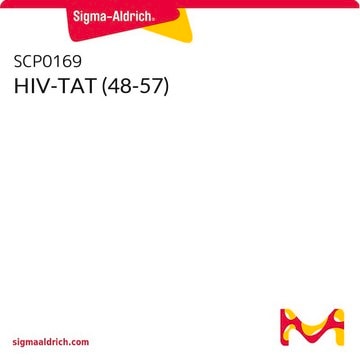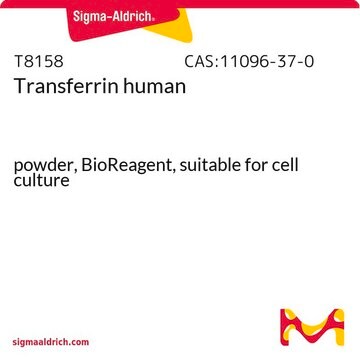H0292
HIV-1 Tat Peptide
≥97% (HPLC), lyophilized powder
About This Item
Productos recomendados
Nombre del producto
HIV-1 Tat Protein (47-57),
origen biológico
synthetic
Nivel de calidad
Formulario
lyophilized powder
solubilidad
deionized water: soluble
Condiciones de envío
dry ice
temp. de almacenamiento
−20°C
cadena SMILES
NCCCC[C@H](NC(=O)[C@H](CCCNC(N)=N)NC(=O)CNC(=O)[C@@H](N)Cc1ccc(O)cc1)C(=O)N[C@@H](CCCCN)C(=O)N[C@@H](CCCNC(N)=N)C(=O)N[C@@H](CCCNC(N)=N)C(=O)N[C@@H](CCC(N)=O)C(=O)N[C@@H](CCCNC(N)=N)C(=O)N[C@@H](CCCNC(N)=N)C(=O)N[C@@H](CCCNC(N)=N)C(O)=O
InChI
1S/C64H118N32O14/c65-25-3-1-11-39(89-50(101)38(13-5-27-81-59(69)70)88-48(99)34-87-49(100)37(67)33-35-19-21-36(97)22-20-35)51(102)90-40(12-2-4-26-66)52(103)91-41(14-6-28-82-60(71)72)53(104)92-43(16-8-30-84-62(75)76)55(106)95-45(23-24-47(68)98)57(108)94-42(15-7-29-83-61(73)74)54(105)93-44(17-9-31-85-63(77)78)56(107)96-46(58(109)110)18-10-32-86-64(79)80/h19-22,37-46,97H,1-18,23-34,65-67H2,(H2,68,98)(H,87,100)(H,88,99)(H,89,101)(H,90,102)(H,91,103)(H,92,104)(H,93,105)(H,94,108)(H,95,106)(H,96,107)(H,109,110)(H4,69,70,81)(H4,71,72,82)(H4,73,74,83)(H4,75,76,84)(H4,77,78,85)(H4,79,80,86)/t37-,38-,39-,40-,41-,42-,43-,44-,45-,46-/m0/s1
Clave InChI
RAVVEEJGALCVIN-AGVBWZICSA-N
Amino Acid Sequence
Descripción general
Acciones bioquímicas o fisiológicas
Forma física
Otras notas
Código de clase de almacenamiento
11 - Combustible Solids
Clase de riesgo para el agua (WGK)
nwg
Punto de inflamabilidad (°F)
Not applicable
Punto de inflamabilidad (°C)
Not applicable
Elija entre una de las versiones más recientes:
Certificados de análisis (COA)
¿No ve la versión correcta?
Si necesita una versión concreta, puede buscar un certificado específico por el número de lote.
¿Ya tiene este producto?
Encuentre la documentación para los productos que ha comprado recientemente en la Biblioteca de documentos.
Los clientes también vieron
Nuestro equipo de científicos tiene experiencia en todas las áreas de investigación: Ciencias de la vida, Ciencia de los materiales, Síntesis química, Cromatografía, Analítica y muchas otras.
Póngase en contacto con el Servicio técnico










